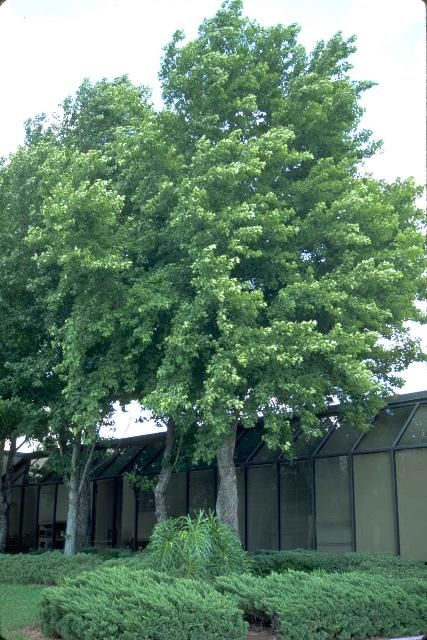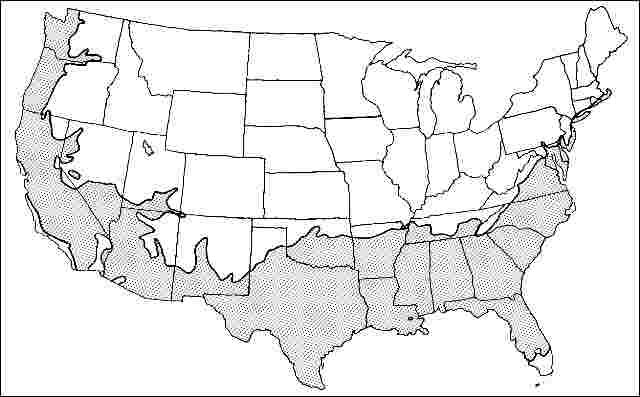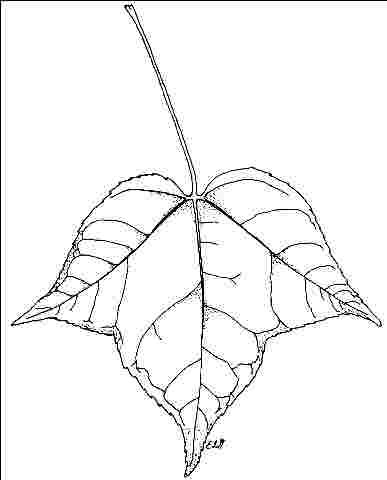Introduction
Formosa Sweetgum has a wide, pyramidal shape when young but eventually grows to a rounded or irregular form, reaching 40 to 60 feet in height with a 35 to 45-foot spread. Young specimens may vary in form and be somewhat irregular. It has a more rounded crown than native Sweetgum. The large, three-lobed leaves, purplish-red when young, are dark green through the growing season and in fall turn a beautiful yellow-red color in the south or red in the north. Branches are covered with characteristic corky projections. Formosa Sweetgum makes a nice park, campus or residential shade tree for large properties.

Credit: Ed Gilman
General Information
Scientific name: Liquidambar formosana
Pronunciation: lick-wid-AM-bar for-moe-SAY-nuh
Common name(s): Formosa Sweetgum, Chinese Sweetgum
Family: Hamamelidaceae
USDA hardiness zones: 7A through 9B (Fig. 2)
Origin: not native to North America
Uses: shade; street without sidewalk; tree lawn > 6 ft wide; Bonsai
Availability: somewhat available, may have to go out of the region to find the tree

Description
Height: 40 to 60 feet
Spread: 35 to 45 feet
Crown uniformity: irregular
Crown shape: pyramidal, oval
Crown density: moderate
Growth rate: moderate
Texture: coarse
Foliage
Leaf arrangement: alternate (Fig. 3)
Leaf type: simple
Leaf margin: serrate
Leaf shape: star-shaped
Leaf venation: palmate
Leaf type and persistence: deciduous
Leaf blade length: 2 to 4 inches, 4 to 8 inches
Leaf color: green
Fall color: yellow, red
Fall characteristic: showy

Flower
Flower color: green
Flower characteristics: not showy
Fruit
Fruit shape: round
Fruit length: 1 to 3 inches
Fruit covering: dry or hard
Fruit color: brown
Fruit characteristics: attracts birds; not showy; fruit/leaves a litter problem
Trunk and Branches
Trunk/bark/branches: branches don't droop; not showy; typically one trunk; thorns
Pruning requirement: needed for strong structure
Breakage: resistant
Current year twig color: gray, brown
Current year twig thickness: thick
Wood specific gravity: unknown
Culture
Light requirement: full sun
Soil tolerances: clay; sand; loam; acidic; occasionally wet; well-drained
Drought tolerance: moderate
Aerosol salt tolerance: unknown
Other
Roots: can form large surface roots
Winter interest: no
Outstanding tree: no
Invasive potential: little invasive potential
Ozone sensitivity: unknown
Verticillium wilt susceptibility: unknown
Pest resistance: resistant to pests/diseases
Use and Management
Be careful when locating Formosa Sweetgum as a street tree since its large, aggressive roots may eventually lift curbs and sidewalks. Plant trees 8 to 10 feet or more away. The fruit may be a litter nuisance to some in the fall, but this is usually only noticeable on hard surfaces, such as roads, patios, and sidewalks. Fruit is softer than Liquidambar styraciflua and probably is less of a nuisance.
Although it grows at a moderate pace, Formosa Sweetgum requires continually-moist soils. It is recommended only for acidic soils since chlorosis develops on soils with a pH over 7.5. It grows very well in clay soils which hold moisture, and tolerates wet soil. Formosa Sweetgum is difficult to transplant in the fall from the field due to a coarse, deep root system on well-drained soil and should be planted from containers or transplanted when young. Grows well as a street tree in confined soil spaces due to its ability to tolerate poorly aerated soil, but only when supplied with adequate moisture. This tree should be tested further for adaptability to urban sites. Liquidambar spp. grow very well for several years after transplanting in Texas and in other areas with a high pH subsoil but chlorosis often develops as some roots establish themselves in the alkaline subsoil. The tree is very susceptible to Endothia canker infection and, in some areas of the country, has devastated the tree.
The cultivar `Afterglow' has lavender purple new growth and rose-red fall color. Liquidambar styraciflua `Rotundiloba' does not set fruit and could be a superior tree.
Propagation is by seeds which may not germinate until the second year.
Pests
Bagworm makes sacks by webbing together pieces of leaves. The insects live in the sacks while they feed. Small numbers of insects may be picked off by hand.
Fall webworm webs over portions of large branches or may completely cover small branches. The insects feed on leaves inside the nest. If practical, nests can be pruned out while small and when the insects are inside. A few nests in large trees are not serious. Trees do not die from infestations of fall webworms.
Leaf miner causes brown blotches on leaves. If injury is caused by leaf miner the browned upper and lower leaf surfaces will be completely separate when the leaf is torn in two.
Cottony-cushion scale, Sweetgum scale, and walnut scale can infest the branches.
Tent caterpillars make nests to live in but leave the nests to feed. Prune out nests at the tips of small branches. Do not burn the nest while it is still in the tree since this will injure the tree and could start an uncontrolled fire.
Diseases
Formosa Sweetgum may be attacked by canker diseases. These diseases cause sunken areas on the trunk and some cause profuse "bleeding". Infected bark and sapwood will be brown and dead. There is no chemical control for canker diseases. Severely infected trees will die. Prune cankers out of lightly infected trees. Maintain tree health by watering and fertilizing.
Endothia gyrosa has devastated Formosa Sweetgum in some areas of USDA hardiness zone 8.
Leaf spots of various types may attack Formosa Sweetgum but are not serious. Rake up infected leaves.